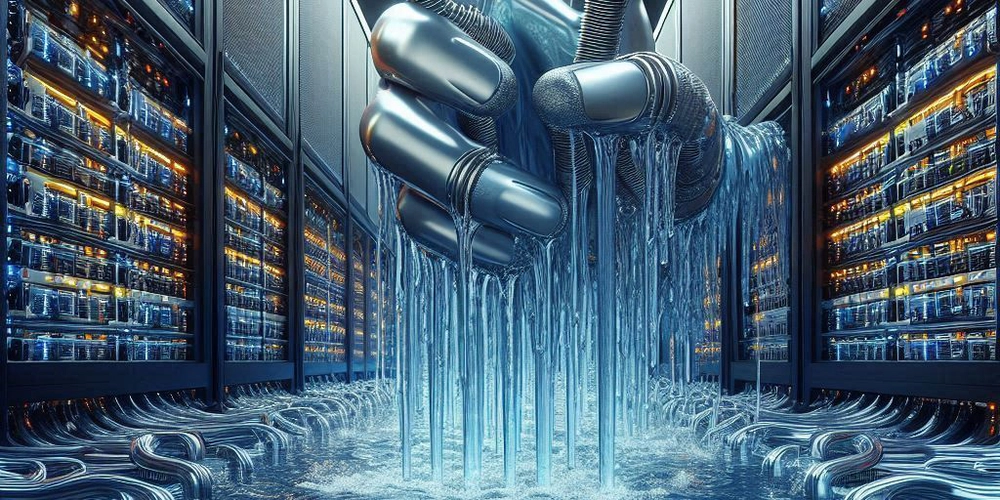How Liquid Cooling is Revolutionizing Data Center Efficiency
Data centers generate extreme heat, and traditional air cooling is struggling. Air cannot remove heat fast enough. This leads to high energy use, poor performance, and rising costs. Liquid cooling is solving these problems. It removes heat quickly, reduces energy consumption, and increases reliability. This method is now used in AI, cloud computing, and high-performance data centers. The shift to liquid cooling is not just an upgrade. It is a complete transformation. It makes data centers faster, quieter, and more cost-effective. Here is how liquid cooling is making data centers more efficient and ready for the future. Liquid Cooling Removes Heat More Efficiently Heat buildup is a major issue in data center services, slowing down hardware and reducing performance, so the data center will now slow down hardware and decrease performance. Here comes a liquid cooler, which can take 1000 times faster transfer of heat as compared to air. Direct-to-Chip Cooling: Targeted Heat Removal This method circulates liquid directly to processors, absorbing heat at the source. By cooling CPUs and GPUs instantly, it prevents overheating and maintains peak performance. Immersion Cooling: Complete Heat Absorption Servers are fully submerged in a special dielectric liquid that absorbs heat evenly. This eliminates the need for fans or air conditioning, making cooling more effective and efficient. Better Cooling, Higher Efficiency Liquid cooling allows the total use of the hardware without lags and other performance issues caused by temperature changes. Continuous and effective performance will reduce failures and allow data centers to accommodate extreme computing demands. Liquid Cooling Increases Server Density Air-cooled servers need extra space for airflow. If servers storages are packed too tightly, they overheat. Liquid cooling removes this problem. Direct-to-chip cooling keeps heat away from processors, allowing servers to be placed closer together. Immersion cooling removes air completely so that server storage can be stacked more densely. More servers in the same space mean higher computing power. This is important for businesses running large workloads. AI and cloud computing demand more processing power. By letting data centers capitalize optimal space management, liquid cooling ends into a performance boost without escalation in energy consumption or footprint. Liquid Cooling Reduces Energy Consumption Did you know? Cooling systems consume nearly 40% of a data center’s electricity. Air conditioning units, fans, and ventilation systems use massive amounts of energy. Liquid cooling cuts this in half. It does not rely on large HVAC systems. Instead, the liquid absorbs heat at the source and removes it quickly. This means less electricity is needed to cool servers. Immersion cooling eliminates fans completely, reducing energy use even further. Some data centers are even reusing excess heat for nearby buildings. This makes operations more sustainable. Lower energy consumption means lower electricity costs. It also reduces the environmental impact of running large data centers. Liquid Cooling Improves Performance Heat is the biggest enemy of performance. When processors get too hot, they slow down to avoid damage—a process called thermal throttling. Air cooling often fails to keep up, leading to inconsistent speeds and lower efficiency. Prevents Thermal Throttling Liquid cooling removes heat instantly, keeping CPUs and GPUs at stable temperatures. This ensures continuous high performance without slowdowns. Maximizes Efficiency With stable cooling, hardware operates at peak efficiency. This results in faster processing, lower latency, and improved workload performance. Enhances User Experience A consistently cool system means no sudden slowdowns or crashes. Users experience smoother operations, quicker response times, and better overall performance. Liquid Cooling Enhances Reliability Heat is a significant contributor to most failures experienced in hardware systems. Overheating components wear out faster. Dust is accumulated by air cooling system malfunctions. Problems, too, arise from those causes. Liquid cooling solves both these problems. Direct-to-chip cooling keeps temperature stable and prevents overheating damage. Immersion cooling eliminates air altogether. Without air, there are no dust problems or corrosion problems. This greatly extends the life of the hardware. With fewer failures, less downtime and lower maintenance costs are achieved. With liquid cooling, servers run longer without needing repairs. The end result has been an increasingly stable system, as well as reliability. For the data center-dependent businesses, this added reliability is basically a bonus. Liquid Cooling Lowers Noise Levels Traditional data centers are noisy due to constantly running fans and air conditioning units. This creates a disruptive work e

Data centers generate extreme heat, and traditional air cooling is struggling. Air cannot remove heat fast enough. This leads to high energy use, poor performance, and rising costs. Liquid cooling is solving these problems.
It removes heat quickly, reduces energy consumption, and increases reliability. This method is now used in AI, cloud computing, and high-performance data centers. The shift to liquid cooling is not just an upgrade. It is a complete transformation. It makes data centers faster, quieter, and more cost-effective.
Here is how liquid cooling is making data centers more efficient and ready for the future.
Liquid Cooling Removes Heat More Efficiently
Heat buildup is a major issue in data center services, slowing down hardware and reducing performance, so the data center will now slow down hardware and decrease performance. Here comes a liquid cooler, which can take 1000 times faster transfer of heat as compared to air.
Direct-to-Chip Cooling: Targeted Heat Removal
This method circulates liquid directly to processors, absorbing heat at the source. By cooling CPUs and GPUs instantly, it prevents overheating and maintains peak performance.Immersion Cooling: Complete Heat Absorption
Servers are fully submerged in a special dielectric liquid that absorbs heat evenly. This eliminates the need for fans or air conditioning, making cooling more effective and efficient.Better Cooling, Higher Efficiency
Liquid cooling allows the total use of the hardware without lags and other performance issues caused by temperature changes. Continuous and effective performance will reduce failures and allow data centers to accommodate extreme computing demands.
Liquid Cooling Increases Server Density
Air-cooled servers need extra space for airflow. If servers storages are packed too tightly, they overheat. Liquid cooling removes this problem. Direct-to-chip cooling keeps heat away from processors, allowing servers to be placed closer together.
Immersion cooling removes air completely so that server storage can be stacked more densely. More servers in the same space mean higher computing power. This is important for businesses running large workloads.
AI and cloud computing demand more processing power. By letting data centers capitalize optimal space management, liquid cooling ends into a performance boost without escalation in energy consumption or footprint.
Liquid Cooling Reduces Energy Consumption
Did you know? Cooling systems consume nearly 40% of a data center’s electricity.
Air conditioning units, fans, and ventilation systems use massive amounts of energy. Liquid cooling cuts this in half. It does not rely on large HVAC systems. Instead, the liquid absorbs heat at the source and removes it quickly.
This means less electricity is needed to cool servers. Immersion cooling eliminates fans completely, reducing energy use even further. Some data centers are even reusing excess heat for nearby buildings.
This makes operations more sustainable. Lower energy consumption means lower electricity costs. It also reduces the environmental impact of running large data centers.
Liquid Cooling Improves Performance
Heat is the biggest enemy of performance. When processors get too hot, they slow down to avoid damage—a process called thermal throttling. Air cooling often fails to keep up, leading to inconsistent speeds and lower efficiency.
Prevents Thermal Throttling
Liquid cooling removes heat instantly, keeping CPUs and GPUs at stable temperatures. This ensures continuous high performance without slowdowns.Maximizes Efficiency
With stable cooling, hardware operates at peak efficiency. This results in faster processing, lower latency, and improved workload performance.Enhances User Experience
A consistently cool system means no sudden slowdowns or crashes. Users experience smoother operations, quicker response times, and better overall performance.
Liquid Cooling Enhances Reliability
Heat is a significant contributor to most failures experienced in hardware systems. Overheating components wear out faster. Dust is accumulated by air cooling system malfunctions. Problems, too, arise from those causes. Liquid cooling solves both these problems.
Direct-to-chip cooling keeps temperature stable and prevents overheating damage. Immersion cooling eliminates air altogether. Without air, there are no dust problems or corrosion problems. This greatly extends the life of the hardware.
With fewer failures, less downtime and lower maintenance costs are achieved. With liquid cooling, servers run longer without needing repairs. The end result has been an increasingly stable system, as well as reliability. For the data center-dependent businesses, this added reliability is basically a bonus.
Liquid Cooling Lowers Noise Levels
Traditional data centers are noisy due to constantly running fans and air conditioning units. This creates a disruptive work environment for engineers. Liquid cooling significantly reduces noise by minimizing or eliminating the need for fans.
Directly cooling to a chip would slow the fans down; immersion would remove fans entirely, making the system almost silent. Noise reduction means also less wear and tear on mechanical parts, means lower maintenance needs and costs.
Liquid Cooling Increases Flexibility and Scalability
Data centers must handle rapidly growing computing demands. AI, cloud computing, and machine learning require more power every year. Air cooling struggles to keep up, but liquid cooling scales effortlessly.
More powerful servers can be added without overheating. Immersion cooling enables modular data centers, allowing businesses to expand easily. As technology evolves, liquid cooling adapts to next-generation workloads, ensuring long-term efficiency.
Why Liquid Cooling is Built for Scalability
- Supports high-density computing without overheating risks.
- Eliminates airflow constraints, allowing flexible hardware placement.
- The capital investment necessary for cooling infrastructure is decreased.
- It adapts to AI, deep learning, and cloud expansion without effort.
- Data centers are being future-proofed, therefore making scaling cheaper and more efficient.
Conclusion: The Future is Liquid
Liquid cooling will change the way data centers work. They can evacuate heat more efficiently so that higher densities can be accommodated without compromising energy efficiency or performance. It strengthens reliability by minimizing noise and enhancing scalability, but most importantly, it lowers operational expenditures.
Corporate giants like Google, Microsoft, and Meta are already putting their eggs in the liquid cooling basket. Traditional cooling will fling open its doors with computing demand-grows. The only avenue out to continue to perform without guilt-edged expenditures for energy is liquid cooling. It is not just an advancement; it is simply the future of data center efficiency.
The question is not if data centers will switch. The question is when.











































































































































































![[The AI Show Episode 142]: ChatGPT’s New Image Generator, Studio Ghibli Craze and Backlash, Gemini 2.5, OpenAI Academy, 4o Updates, Vibe Marketing & xAI Acquires X](https://www.marketingaiinstitute.com/hubfs/ep%20142%20cover.png)




























































































































![[DEALS] The Premium Learn to Code Certification Bundle (97% off) & Other Deals Up To 98% Off – Offers End Soon!](https://www.javacodegeeks.com/wp-content/uploads/2012/12/jcg-logo.jpg)


![From drop-out to software architect with Jason Lengstorf [Podcast #167]](https://cdn.hashnode.com/res/hashnode/image/upload/v1743796461357/f3d19cd7-e6f5-4d7c-8bfc-eb974bc8da68.png?#)








































































































.png?#)

































_Christophe_Coat_Alamy.jpg?#)
 (1).webp?#)





































































































![Apple Considers Delaying Smart Home Hub Until 2026 [Gurman]](https://www.iclarified.com/images/news/96946/96946/96946-640.jpg)
![iPhone 17 Pro Won't Feature Two-Toned Back [Gurman]](https://www.iclarified.com/images/news/96944/96944/96944-640.jpg)
![Tariffs Threaten Apple's $999 iPhone Price Point in the U.S. [Gurman]](https://www.iclarified.com/images/news/96943/96943/96943-640.jpg)




































































































































